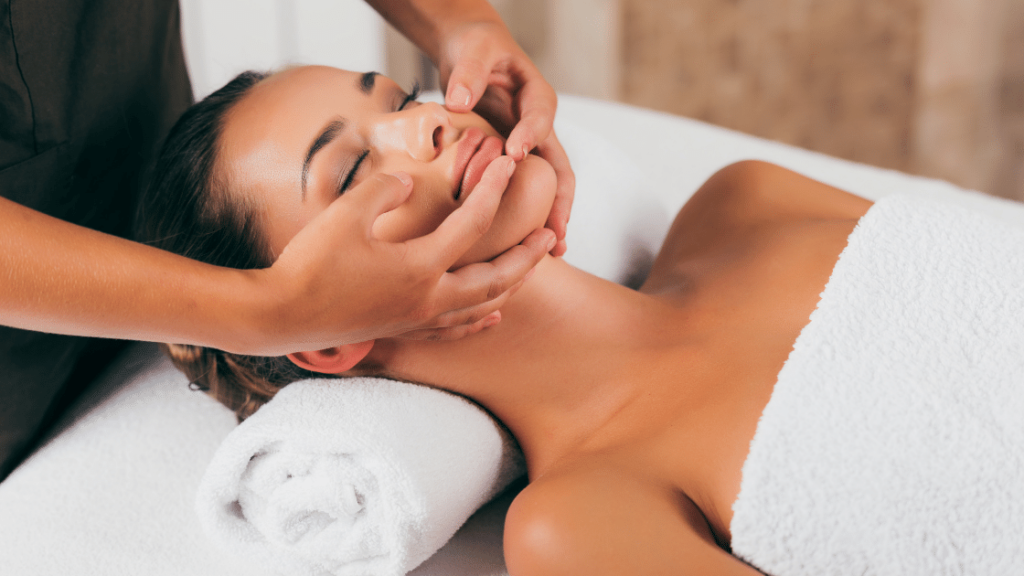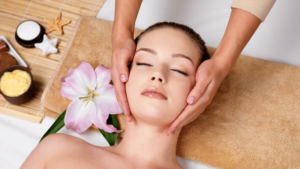Why You Should Get a Face Massage

Oh, massage modalities! There are so many of them! You have deep tissue massage, Swedish massage, lymphatic drainage…all that good stuff, and more!
Now, when you hear the term facial massage, what category do you think the technique falls under? If you’ve never had one, you might think it’s more of a Swedish technique than anything else. I mean, let’s be honest. Whenever you see a photo of a face massage, it looks like a luxurious, fluffy, soothing sort of treatment. Not the kind of thing for tough folk who won’t pay for anything tamer than stabby trigger point therapy.
And most facial massage pictures show a pretty flower beside the client’s head.
Yes, facial massage is relaxing and sometimes added to Swedish massage. But among all the facial massages I’ve given, most of them were performed as part of a corrective massage as opposed to a relaxation massage. The majority of my facial massage clients needed deeper strokes, pin-and-stretch therapy, or lymphatic drainage.
And how is that? How and why would I use deep pressure on somebody’s face?! And isn’t pin-and-stretch therapy supposed to be for sports injuries? And what is lymphatic drainage?
We’ll get into all of that! I’ll start with a list of common conditions a facial massage can treat, and follow with a basic rundown of what to expect from your session.
What Does Facial Massage Treat?
Headaches
Migraines, tension headaches, cluster headaches, etc. Facial massage is often used to address underlying issues that contribute to headaches.
If your headache is chiefly stress-related, the calming aspect of a face massage eases the cause. Should your headache be muscle-related — yes, we sometimes forget that we have facial and cranial muscles — the loosened knots can offer relief. Did you know that you also have pressure points on your face and head? Sometimes all it takes is a pinch to the pressure point to reduce the ache.
Jaw Pain
Temporomandibular joint dysfunction (aka TMJ) is another common reason to seek facial massage. Bruxism, the grinding of one’s teeth during sleep, is another one. No matter the cause of the jaw pain, facial massage can help.
You can overuse and injure your jaw muscles — the buccinator and masseter — just like you can with any muscle. And just like with any other muscle, they can get adhesed and need some loosening up. When it comes to jaw pain, deeper touch and pin-and-stretch techniques are often applied to smooth out the knots.
Sinus Pressure
When you’ve got sinus issues, you’ll benefit from some lymphatic drainage. Massage improves your lymph flow, as applied pressure literally pushes the lymph in the direction of correction. (The direction of correction being towards the lymph nodes, so the wastes carried by your lymph can be neutralized.)
When you receive lymphatic drainage on your legs, your therapist will work towards the nodes near your groin. When you receive it on your back or arms, the glides will flow to the nodes in your armpits. For sinus pressure, a facial massage moves the lymph toward the nodes in your neck and around your jaw. The toxins causing sinus pressure should flush on out!
Stress Relief
Endorphins, serotonin, and dopamine are three feel-good chemicals. When you receive a massage, those happy chemicals surge throughout your body. And then there’s the stress hormone called cortisol, whose levels decrease when you receive a massage. Any massage modality will offer this benefit, and a facial massage is no different.
But there’s a little extra bonus to a relaxing face massage, as your scalp is very close by and full of nerve endings. The nerve endings in hair follicles are very sensitive, and stress tends to exit the body when they’re touched! For people who don’t mind having their scalp touched, at least.
Skin Rejuvenation
If facial massage isn’t part of your skincare routine yet, consider adding it! Boosting your circulation, facial massage sends an increased flow of blood and oxygen to your skin. The enhanced circulation leads to increased cell growth, which can brighten your skin tone and reduce fine lines.
And if you struggle with acne, face massage might be able to help with that too! As mentioned earlier, massage flushes toxins and wastes from your body. When toxins build up in your skin, you’re at risk for a breakout. Let lymphatic drainage do its work for your blemishes as well as your sinuses.
What to Expect During a Face Massage
This depends on your goals.
If you have a headache, you can expect to have a focus on your temples and jaw. But your facial massage will likely involve scalp work and occipital traction as well. Your occiput is a notch at the base of the skull, and nasty trigger points like to hide out in there and cause headaches. The acupressure points between your eyebrows, above your lip, and on your ears may also be treated.
For jaw pain, your therapist may use pin-and-stretch techniques on your jaw muscles. This usually involves deeper pressure and can sometimes encounter a trigger point. Your therapist will place their fingers at the origin of your buccinator or masseter (lateral sides of the mandible), and you’ll be instructed to slowly open your mouth. As you depress your jaw, your therapist’s fingers will glide toward your cheekbone until it reaches the muscle’s insertion site. Activating the jaw like this lets the strokes breakthrough knots as the muscle lengthens.
When fighting off sinus pressure, lymphatic drainage techniques will be used. The session will probably start with a massage on the areas superficial to your sinuses; the frontal sinuses on your forehead, the ethmoid sinuses between the corners of your eyes, and the maxillary sinuses lateral to either side of your nose. From there, you’ll receive a massage that draws all of its glides toward the lymph nodes around your jaw and neck.
For overall stress relief, it really all depends on what you find most relaxing. Do you like having thumbs dug into your jaw? Or do you like light feathery strokes on your cheeks and forehead? A client of mine once sent me the video below and asked if I could mimic it. I did! And her stress melted away, just like that. But like I said, everyone’s idea of relaxing is different. You’re going to get a facial massage customized for your ultimate stress relief!
And lastly, what can you expect if you’re looking for skin rejuvenation? Gentle upward strokes should be applied, as downward strokes can cause your facial muscles to frown. I think we all know frowning isn’t helpful when it comes to wrinkles. Also, consider bringing in your own skincare cream to your next session. If you have a trusted product for acne, anti-aging, excessive dryness, or whatever, ask if your therapist is ok with using it in place of massage oil.
Now You Know Why You Should Get a Face Massage!
Ask about facial massage at your next session. Your head, jaw, sinuses, brain, and skin will thank you!

Katrina Jenkins
Author, Licensed Massage Therapist
Katrina Jenkins graduated from Towson University in 2013 with a Bachelor’s Degree in Health Science and worked as a nurse’s aide briefly before pursuing her true passion. She graduated from the Massage Therapy Institute of Colorado in April 2016 with honors and completed the Touch of Healers Scholarship Program the following summer. She has been a part of the Moyer Total Wellness Team since the summer of 2017.
Photo Credit:
Canva by LightFieldStudios from Getty Images Pro
Canva by Valua Vitality
Resources:
Cafasso, Jacquelyn. “Sinus Massage: 3 Techniques to Relieve Pain.” Healthline, 23 Jan. 2019, www.healthline.com/health/sinus-massage.
Seliger, Susan. “Massage Therapy for Stress Relief, Tension, Headaches, Muscle Tightness, and More.” WebMD, WebMD, 1 June 2008, www.webmd.com/balance/stress-management/features/massage-therapy-stress-relief-much-more.
Wong, Cathy. “Can Massage Therapy Ease TMJ Pain?” Verywell Health, 21 Jan. 2020, www.verywellhealth.com/massage-therapy-for-tmj-88852.

